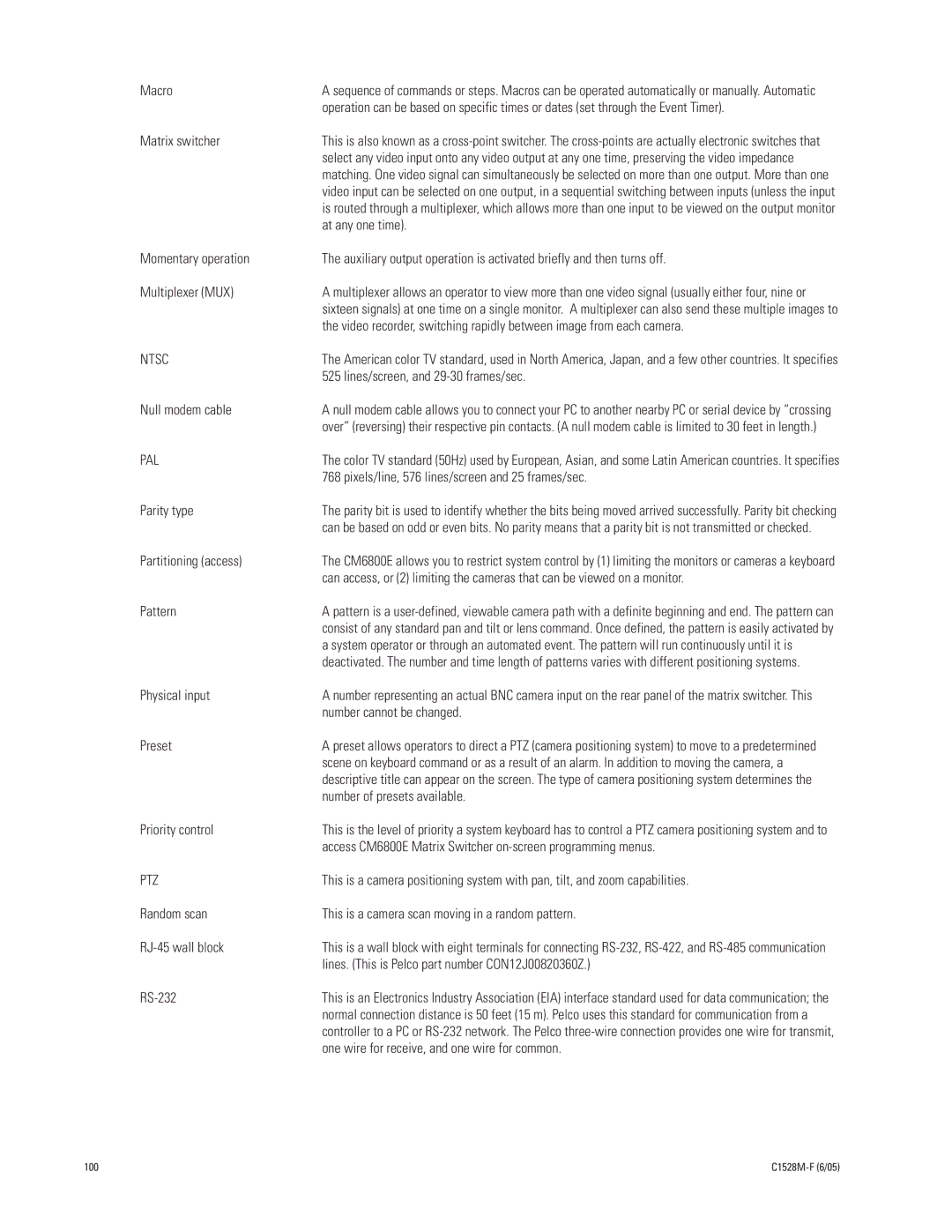Macro | A sequence of commands or steps. Macros can be operated automatically or manually. Automatic |
| operation can be based on specific times or dates (set through the Event Timer). |
Matrix switcher | This is also known as a |
| select any video input onto any video output at any one time, preserving the video impedance |
| matching. One video signal can simultaneously be selected on more than one output. More than one |
| video input can be selected on one output, in a sequential switching between inputs (unless the input |
| is routed through a multiplexer, which allows more than one input to be viewed on the output monitor |
| at any one time). |
Momentary operation | The auxiliary output operation is activated briefly and then turns off. |
Multiplexer (MUX) | A multiplexer allows an operator to view more than one video signal (usually either four, nine or |
| sixteen signals) at one time on a single monitor. A multiplexer can also send these multiple images to |
| the video recorder, switching rapidly between image from each camera. |
NTSC | The American color TV standard, used in North America, Japan, and a few other countries. It specifies |
| 525 lines/screen, and |
Null modem cable | A null modem cable allows you to connect your PC to another nearby PC or serial device by “crossing |
| over” (reversing) their respective pin contacts. (A null modem cable is limited to 30 feet in length.) |
PAL | The color TV standard (50Hz) used by European, Asian, and some Latin American countries. It specifies |
| 768 pixels/line, 576 lines/screen and 25 frames/sec. |
Parity type | The parity bit is used to identify whether the bits being moved arrived successfully. Parity bit checking |
| can be based on odd or even bits. No parity means that a parity bit is not transmitted or checked. |
Partitioning (access) | The CM6800E allows you to restrict system control by (1) limiting the monitors or cameras a keyboard |
| can access, or (2) limiting the cameras that can be viewed on a monitor. |
Pattern | A pattern is a |
| consist of any standard pan and tilt or lens command. Once defined, the pattern is easily activated by |
| a system operator or through an automated event. The pattern will run continuously until it is |
| deactivated. The number and time length of patterns varies with different positioning systems. |
Physical input | A number representing an actual BNC camera input on the rear panel of the matrix switcher. This |
| number cannot be changed. |
Preset | A preset allows operators to direct a PTZ (camera positioning system) to move to a predetermined |
| scene on keyboard command or as a result of an alarm. In addition to moving the camera, a |
| descriptive title can appear on the screen. The type of camera positioning system determines the |
| number of presets available. |
Priority control | This is the level of priority a system keyboard has to control a PTZ camera positioning system and to |
| access CM6800E Matrix Switcher |
PTZ | This is a camera positioning system with pan, tilt, and zoom capabilities. |
Random scan | This is a camera scan moving in a random pattern. |
This is a wall block with eight terminals for connecting | |
| lines. (This is Pelco part number CON12J00820360Z.) |
| This is an Electronics Industry Association (EIA) interface standard used for data communication; the |
| normal connection distance is 50 feet (15 m). Pelco uses this standard for communication from a |
| controller to a PC or |
| one wire for receive, and one wire for common. |
100 |
|
